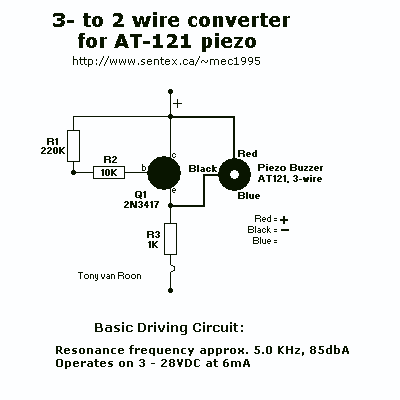

Here is how you can easily differentiate between an Active buzzer and a passive buzzer:Īs you can see in the picture below, the passive buzzer doesn’t “usually” have a backside cover, unlike the Active buzzer. Note that there is a hole in the top casing which allows the sound waves to travel through.

Inside a passive buzzer, you can find the piezoelectric disc, a PCB, and it has no backside cover.

Let’s take a look inside a Passive Buzzer to see how it’s made. Rated Voltage 3 ~ 5 V Sound Output at 10cm with 2048Hz Square Wave ≥85 dB Frequency Range 50 ~ 14,000 Hz Resonant Frequency 2,048 Hz Inside a Passive Buzzer Those are the specs of a passive buzzer as found in its datasheet. And it only needs a PWM signal that you can feed to the passive buzzer using a Timer555 circuit or an Arduino board. But it also allows us to generate whatever note frequency we want to play.Ĭompared to the fixed tone that active buzzers generate, passive buzzers are more suitable for projects where you need to control the audio tone frequency. Therefore, it’s a little bit harder to control compared to Active buzzers. Passive Buzzers on the other hand need an AC voltage signal in order to vibrate and make sound.
PIEZO BUZZER FREQUENCY RESPONSE DRIVER
Inside an active buzzer, you can find the piezoelectric disc, the oscillator driver PCB, and a backside casing of resin or plastic. Let’s take a look inside an Active Buzzer to see how it’s made. Rated Voltage 6V DC Operating Voltage 4 to 8V DC Rated Current ≤30mA Sound Output at 10cm ≥85dB Resonant Frequency 2,300 ☓00Hz Tone Continuous Inside an Active Buzzer Those are the specs of an active buzzer (6v DC) as found in its datasheet. So be careful when you’re hooking it up with a microcontroller or any drive circuit. Keep in mind that buzzers are polarized electronic devices which means they have a positive lead & a negative lead (like LEDs, capacitors, etc). For example, a 6v buzzer will work with a DC voltage in the range (4v-8v). The working voltage of an Active buzzer falls in the range of 3.3v up to 12v and you need to check the manufacturer data to know the exact working DC voltage for your buzzer. It acts like a digital output device (like an LED or something) that you either turn ON or OFF. You only need to feed it with constant voltage and it’ll play a continuous buzzer tone until you drive it LOW. Active BuzzerĪctive Buzzers are the easiest to use, as they have internal oscillators. This is called a Passive Buzzer.Īnother type of buzzer doesn’t need a varying voltage, you just give it constant voltage and it has an internal chopper (oscillator) circuit that turns the constant voltage to a square wave and feeds that to the piezo disc to generate a fixed-frequency tone. And it needs a voltage of 3.3v up to 12v to work, the working voltage is stated on the manufacturer page so make sure you get a 5v buzzer which is going to work just as fine with all microcontrollers.Īpplying voltage to the piezo buzzer terminals will cause a slight deformation in the piezo disc and by changing this voltage the piezo disc will vibrate and produce the buzzer sound we all know. A piezo buzzer is a polarized electronic device which means it has a positive lead & a negative lead.


 0 kommentar(er)
0 kommentar(er)
